Potřebujeme váš souhlas k využití jednotlivých dat, aby se vám mimo jiné mohly ukazovat informace týkající se vašich zájmů. Souhlas udělíte kliknutím na tlačítko „OK“.
ASTM D7015-13
Standard Practices for Obtaining Intact Block (Cubical and Cylindrical) Samples of Soils
Automaticky přeložený název:
Standardní postupy pro získání Intact blok (krychlový a válcové) Vzorky půdy
NORMA vydána dne 1.7.2013
Informace o normě:
Označení normy: ASTM D7015-13
Poznámka: NEPLATNÁ
Datum vydání normy: 1.7.2013
Kód zboží: NS-37302
Počet stran: 7
Přibližná hmotnost: 21 g (0.05 liber)
Země: Americká technická norma
Kategorie: Technické normy ASTM
Kategorie - podobné normy:
Anotace textu normy ASTM D7015-13 :
Keywords:
block sample, block sampling, cylindrical sampling, geologic investigations, intact, sampling, soil exploration, soil investigations, subsurface investigations, ICS Number Code 13.080.05 (Examination of soil in general)
Doplňující informace
| Significance and Use | ||||||||||||||||||||||||||
|
4.1 Intact block samples are suitable for laboratory tests where large-sized samples of intact material are required or where such sampling is more practical than conventional tube sampling (Practices D1587 and D6519), or both. 4.2 The intact block method of sampling is advantageous where the soil to be sampled is near the ground surface. It is the best available method for obtaining large intact samples of very stiff and brittle soils, partially cemented soils, and some soils containing coarse gravel. 4.3 Excavating a column of soil may relieve stresses in the soil and may result in some expansion of the soil and a corresponding decrease in its unit weight (density) or increase in sampling disturbance, or both. Usually the expansion is small in magnitude because of the shallow depth. Stress changes alone can cause enough disturbances in some soils to significantly alter their engineering properties. 4.4 The chain saw has proved advantageous in sampling difficult soils, which are blocky, slickensided, or materials containing alternating layers of hard and soft material.1.1 These practices outline the procedures for obtaining intact block (cubical and cylindrical) soil samples. 1.2 Intact block samples are obtained for laboratory tests to determine the strength, consolidation, permeability, and other geotechnical engineering or physical properties of the intact soil. 1.3 Two sampling practices are presented. Practice A covers cubical block sampling, while Practice B covers cylindrical block sampling. 1.4 These practices usually involve test pit excavation and are limited to relatively shallow depths. Except in the case of large diameter (that is, greater than 3/4 m) bored shafts of circular cross-section in unsaturated soils, for depths greater than about 1 to 11/2 metres or depths below the water table, the cost and difficulties of excavating, cribbing, and dewatering generally make block sampling impractical and uneconomical. For these conditions, use of a thin-walled push tube soil sampler (Practice D1587), a piston-type soil sampler (Practice D6519), or Hollow-Stem Auger (Practice D6151), Dennison, or Pitcher-type soil core samplers, or freezing the soil and coring may be required. These practices do not address environmental sampling; consult Guides D6169 and D6232 for information on sampling for environmental investigations. 1.5 Successful sampling of granular materials requires sufficient cohesion, cementation, or apparent cohesion (due to moisture tension (suction)) of the soil for it to be isolated in a column shape without undergoing excessive deformations. Additionally, care must be exercised in the excavation, preservation and transportation of intact samples (see Practice D4220, Group D). 1.6 The values stated in SI units are to be regarded as standard. No other units of measurement are included in this standard. 1.7 All observed and calculated values shall conform to the guidelines for significant digits and rounding established in Practice D6026 unless superseded by this standard. 1.7.1 The procedures used to specify how data are collected/recorded or calculated in this standard are regarded as the industry standard. In addition they are representative of the significant digits that generally should be retained. The procedures used do not consider material variation, purpose for obtaining the data, special purpose studies, or any considerations for the user’s objectives; it is common practice to increase or reduce significant digits of reported data to be commensurate with these considerations. It is beyond the scope of this standard to consider significant digits used in analytical methods for engineering design. 1.8 These practices offer a set of instructions for performing one or more specific operations. This document cannot replace education or experience and should be used in conjunction with professional judgment. Not all aspects of these practices may be applicable in all circumstances. This ASTM standard is not intended to represent or replace the standard of care by which the adequacy of a given professional service must be judged, nor should this document be applied without consideration of a project's many unique aspects. The word "Standard" in the title of this document means only that the document has been approved through the ASTM consensus process. 1.9 This standard does not
purport to address all of the safety concerns, if any, associated
with its use. It is the responsibility of the user of this standard
to establish appropriate safety and health practices and determine
the applicability of regulatory requirements prior to use.
Standard Terminology Relating to Soil,
Rock, and Contained Fluids Standard Practice for Thin-Walled Tube
Sampling of Soils for Geotechnical Purposes Standard Practice for Sampling of Soil
Using the Hydraulically Operated Stationary Piston Sampler Standard Guide for Selection of Sampling
Equipment for Waste and Contaminated Media Data Collection
Activities Standard Guide for Selection of Soil and
Rock Sampling Devices Used With Drill Rigs for Environmental
Investigations Standard Practice for Using Hollow-Stem
Augers for Geotechnical Exploration and Soil Sampling Standard Practice for Using Significant
Digits and Data Records in Geotechnical Data Standard Guide for Field Logging of
Subsurface Explorations of Soil and Rock (Withdrawn 2021) Standard Practices for Preserving and
Transporting Soil Samples Standard Specification for Poly(Vinyl
Chloride) (PVC) Plastic Pipe, Schedules 40, 80, and 120 (Includes
all amendments and changes 10/8/2021). Standard Practice for Description and
Identification of Soils (Visual-Manual Procedures) (Includes all
amendments and changes 4/4/2018). Standard Test Method for Density of Soil
in Place by the Drive-Cylinder Method (Includes all amendments and
changes 4/17/2018). Standard Practice for Minimum
Requirements for Agencies Engaged in Testing and/or Inspection of
Soil and Rock as Used in Engineering Design and Construction |
Podobné normy:
Historická
1.1.2013
Historická
1.1.2010
Historická
1.7.2010
Historická
1.7.2010
Historická
1.5.2010
Historická
1.8.2013
Doporučujeme:
Aktualizace technických norem
Chcete mít jistotu, že používáte pouze platné technické normy?
Nabízíme Vám řešení, které Vám zajistí měsíční přehled o aktuálnosti norem, které používáte.
Chcete vědět více informací? Podívejte se na tuto stránku.


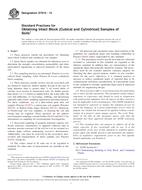
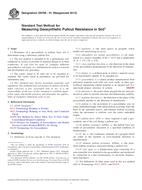 ASTM D6706-01(2013)..
ASTM D6706-01(2013)..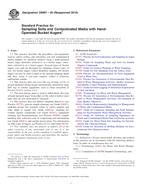 ASTM D6907-05(2010)..
ASTM D6907-05(2010)..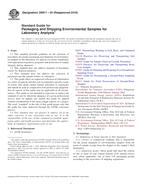 ASTM D6911-03(2010)..
ASTM D6911-03(2010)..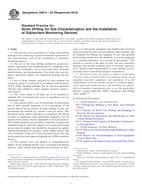 ASTM D6914-04(2010)..
ASTM D6914-04(2010)..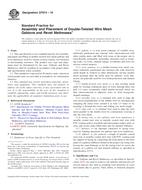 ASTM D7014-10
ASTM D7014-10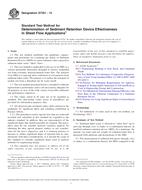 ASTM D7351-13
ASTM D7351-13
 Cookies
Cookies
